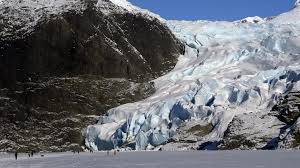Glacier Melting and Climate Change

- 25 Feb 2025
Context:
The world’s glaciers are melting at an alarming rate due to anthropogenic climate change, making them one of the leading contributors to global sea-level rise. Recent studies have revealed that more than 7 trillion tonnes of ice have been lost since 2000, with 2023 marking the worst year on record.
Key Data and Trends
- Between 2000 and 2023, glaciers lost 6.54–7 trillion tonnes of ice, contributing approximately 18 mm to global sea levels.
- The rate of glacier melt increased by 36% over the past decade:
- 2000–2011: 255 billion tonnes lost annually
- 2011–2023: 346 billion tonnes annually
- 2023 alone: 604 billion tonnes lost — the highest annual loss recorded
- Globally, glaciers have lost 5% of their ice, with regional losses ranging from 2% to 39%.
- Alaska is the fastest-melting region, losing 67 billion tonnes per year (22% of global glacier mass loss).
- The Canadian Arctic (20%), Greenland periphery (13%), and Southern Andes (10%) are also major contributors.
- Central European glaciers are shrinking the fastest in relative terms, having lost 39% of their volume since 2000.
Causes of Glacier Meltdown
- Rising global temperatures due to greenhouse gas emissions from fossil fuel combustion.
- Extreme heatwaves and record summer temperatures, especially in vulnerable regions like the Alps and Andes.
- Reduced snowfall, leading to insufficient accumulation to balance seasonal melting.
- Human-induced climate change, confirmed as the primary driver of accelerated glacier loss.
Impacts of Glacier Melting
- Sea Level Rise
- Glacier melt contributes more to sea-level rise than ice loss from Greenland and Antarctica.
- Currently accounts for 0.75 mm/year of sea-level rise; projected to increase further.
- Water Resources & Scarcity: Melting glaciers provide short-term water surpluses but pose a long-term threat of freshwater scarcity, especially for regions dependent on glacier-fed rivers (e.g., Central Asia, Central Andes).
- Geohazards & Natural Disasters: Glacier retreat increases the risk of glacial lake outburst floods (GLOFs), landslides, and downstream flooding.
- Biodiversity Loss: Shrinking glaciers affect freshwater ecosystems and species reliant on glacial water.
- Economic Disruptions: Sectors like agriculture and tourism are adversely impacted due to changes in water availability and scenic landscape loss.
Scientific Insights and Global Assessments
- The Glacier Mass Balance Intercomparison Exercise (GlaMBIE) led by international experts used unified satellite and field data to provide the most accurate glacier loss estimates to date.
- Glaciers are now recognized as apolitical indicators of climate change, painting an unbiased picture of global warming trends.
- The IPCC stresses that without rapid cuts in emissions, glacier melt will continue or accelerate throughout the century, worsening its contribution to sea-level rise and regional climate vulnerabilities.
- Glaciers contribute 20% to observed global sea-level rise (2003–2016), behind only thermal expansion (33%), and more than the Greenland Ice Sheet (17%).
Conclusion
Glaciers are not just scenic features; they are critical to Earth’s hydrological and climatic systems. Their rapid melting signals an urgent planetary emergency that demands intensified climate action, focused on mitigation, adaptation, and international cooperation. For India, where Himalayan glaciers are vital for river systems and agriculture, this global trend holds serious implications for water security, disaster risk management, and sustainable development.
